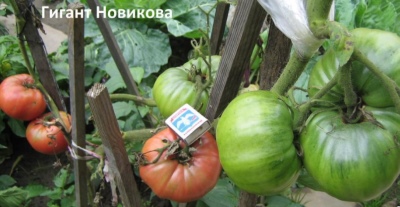
- Authors: Russian selection
- Category: grade
- Growth type: indeterminate
- Appointment: fresh consumption, for juice, for ketchup and tomato paste
- Ripening period: mid-early
- Ripening time, days: 120-125
- Growing conditions: for film greenhouses, for greenhouses
- Bush size: tall
- Bush height, cm: up to 200
- The amount of dry matter,%: 6
Although Russian breeders have already offered many attractive varieties of tomatoes, the Novikov Gigant will at least not yield to most of them. The advantages of culture in everyday gardening are undeniable. However, they are achieved only with careful care, which is impossible without knowing even seemingly insignificant subtleties.
Breeding history
As already noted, the Gigant Novikova is a product of the Russian breeding school. This plant can hardly be called a completely new type. It was created by amateurs, and for quite some time. The culture was registered in 1990. From that moment on, the Novikov Giant has remained one of the favorite types in domestic gardening.
Description of the variety
The variety stands out favorably among the number of indeterminate tomatoes. The bushes can grow up to 2 m. They can be grown in conventional and plastic greenhouses.
The main qualities of the fruit
The berries of Gigant Novikov are pink in color. This basic color is mixed with a raspberry tone. A greenish area develops near the stalk. The mass of berries in most cases reaches 0.5-0.6 kg. But there are also genuine "giants" among them, reaching a mass of 1.5 kg.
In shape, the fruit resembles a flat circle. It is characterized by a high degree of ribbing. 4.5 or 6 tomato berries are formed on 1 brush. Farmers note the good keeping quality of the crop. A thin peel is also characteristic.
Taste characteristics
You can use the crop fresh. Fruits are also suitable for obtaining juices, ketchups, tomato pastes. In all of these variations, the flavor is interesting enough for the plant to deserve attention. The main role is played by the sweet part of the taste. It, however, is also diluted with an expressive sourness; the berries will be fleshy and dense, and the proportion of dry matter in them is 6%.
Ripening and fruiting
The Novikov giant is a mid-early culture. It yields a harvest 120-125 days after the green shoots emerge from the ground. Most often, the berries of this tomato are harvested in July. Alas, the variety cannot boast of especially long fruiting.
Yield
The Novikov giant is considered to be a fairly prolific plant. The collection from 1 bush reaches 5 and even 6 kg. Both large and small berries can form on one cluster.
The timing of planting seedlings and planting in the ground
The time to plant seeds in containers usually occurs in March. If this deadline is met, then you can wait for the receipt of ready-made strong seedlings during May. Experts advise to closely monitor its condition and evaluate the characteristics of the weather in order to make the right choice. No shelter is required for the planted seedlings. It is necessary to form bushes in 1 or 2 stems.

Growing tomato seedlings is an extremely important process, because it largely depends on whether the gardener will be able to harvest at all. All aspects must be taken into account, from seedbed preparation to planting in the ground.
Landing scheme
Usually 3 or 4 plants are placed per 1 m2. A denser planting increases the yield. Less dense - allows for easier care. The most common layout is 400x600 mm.The experience of gardeners shows that there is simply no point in looking for other options.

Growing and care
Like many other types of tomatoes, the Novikov Giant needs a garter, and shaping, and the removal of stepsons at their first appearance. The bushes will have to be tied to supports. All foliage below the first flower brush must be removed.
This tomato is very sensitive to changes in soil composition. During the growing season, it is necessary to carry out at least 3 additional dressings. More than any special measures that are atypical for other plants will not be required.




A plant needs different micronutrients at each stage of growth. All fertilizers can be divided into two groups: mineral and organic. Folk remedies are often used: iodine, yeast, bird droppings, eggshells.
It is important to observe the rate and period of feeding. This also applies to folk remedies and organic fertilizers.
Disease and pest resistance
Giant Novikov's immunity is strong enough. But you still have to help the plant so that it successfully survives bad conditions. Preventive treatments will definitely not be superfluous. The danger is posed by scoops, whiteflies and other insect pests. Special insecticides help to fight them.


Growing regions
The variety performs well in the southern regions. There it can be cultivated even outdoors. In the Volga regions and in other areas of the middle lane, protective shelters are strongly recommended. In the Urals and Siberia, one cannot do without greenhouses at all. Subject to proper weather and competent agricultural technology, the taste of the crop will not differ between closed and open plantings.
Review overview
The high growth of the bushes cannot be considered some kind of disadvantage. Gardeners note that because of it, there are no significant problems in care.Fruiting is sometimes irregular and unstable. The taste can be discouraging in some seasons. But even all these shortcomings do not interfere with the stable popularity of Giant Novikov.

























































































